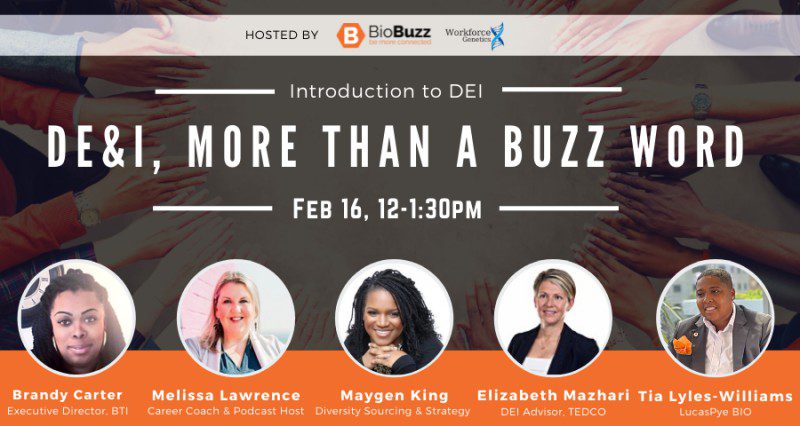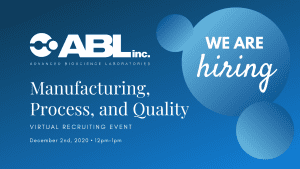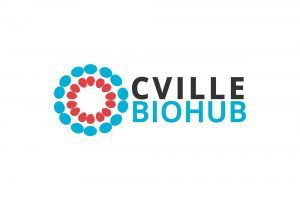
How Life Sciences Companies Can Successfully Execute and Sustain Diversity, Equity, and Inclusion (DE&I) Initiatives
The life sciences industry is booming in our region and globally, which has put the need for more biotech talent in the spotlight. This urgent need for talent has finally made diversity and inclusion part of every discussion about talent acquisition and workforce development. Companies large and small are starting to take action to ensure their workforce demographics are right-sized to match a diverse workforce population.
On February 16th, BioBuzz and Workforce Genetics hosted “DE&I: More than a Buzzword”, a virtual event that brought together Diversity, Equity and Inclusion (DE&I) thought leaders from across the life sciences industry.
The panel, which was moderated by Ezekiel Kelley of BioBuzz/Workforce Genetics, included Tia Lyles-Williams, Founder and CEO, LucasPye BIO and HelaPlex; Brandy Carter, PhD, Director, Biotechnical Institute (BTI) of Maryland; Melissa Lawrence, Leadership Coach, former Associate Director, Talent Development at AstraZeneca; Maygen King, Senior Diversity and Inclusion Talent Strategist at Thermo Fisher; and Elizabeth Mazhari, DEI and Investment Advisor, at TEDCO.
“This panel was a great opportunity to dive deeper and hear directly from life science professionals about their individual experiences with attracting, training, and retaining a diverse biohealth workforce,” stated Kelley, Director of Operations and Workforce Solutions at Workforce Genetics.
The panel discussion was vibrant, wide-ranging, and insightful. Below is a recap of some of the panel highlights.
Behavior and Accountability Keys to Diversity, Equity and Inclusion Initiatives
The panel kicked off the discussion by addressing the importance of behaviors and accountability when it comes to building and sustaining a strong DE&I program at a company.
“When we talk about corporate initiatives we often say it needs to come from the bottom up, but when it comes to DE&I you have to start at the top,” stated Lyles-Williams.
“If you don’t start at the top DE&I will just be a fad and a term to throw around and no one will be accountable for the culture starting to change and trend in the right direction,” she added. “We can’t just leave diversity up to individual managers. It has to be intentional, numbers-driven, and systematic.”
“There are a lot of big corporations that are tying diversity behavior to money and bonuses. It’s nice to say ‘I like this’, but when you start messing with finances and bonuses, it changes the game completely. That’s a big statement coming from the top down about accountability,” stated King.
“The behavior in the organization matters. If you have all these diversity programs and required training for leadership, yet there’s no accountability, then you break the thread of the culture the program is trying to build. You learn from behaviors. Things can come apart when…a company starts to make exceptions to a zero-tolerance policy,” shared Lawrence.
“It all boils down to behavior and accountability,” she added.
Tips for Managing Up When It Comes to DE&I
Supporting DE&I ideas on an individual level and having casual conversations with colleagues is one thing—finding the right approach to securing company buy-in for formal DE&I initiatives is another. The panel explored what an organization’s role should be and how DE&I advocates can make their voices heard at the executive level.
“I run a smaller organization, so I’m going to come at this from a different direction. I think it’s important to create safe spaces for tough conversations for staff and students. I want to make sure it is equitable for everyone that walks through our doors,” shared Carter.
Lyles-Williams echoed Carter’s sentiment about creating safe platforms for DE&I conversations: “When I was at Human Genome Sciences (HGS) at the start of my career, Barack Obama had just won the election and everyone started talking about DE&I. During Black History Month, instead of honoring historical figures, we wanted to honor our African-American workers on site.”
“I had to get buy-in from HR because I was just a low-level associate working on the floor. We hooked up with HR and got the conversation started. HR was the mediator…but if it comes from HR now everyone is on the same playing field and anxiety is down and they can help navigate through the process,” she added.
“Another avenue is Employee Resource Groups or ERGs. For me getting involved in our African Heritage ERG was major; we had VPs and other high-up leadership in the group. Whenever we had an issue we’d bring it to our group and they’d handle it. Being a part of that group and being able to speak your voice is very beneficial,” stated King.
Integrating DE&I into Recruiting and Workforce Development Strategies
The panel also engaged around how DE&I can be integrated into talent acquisition and workforce development.
“When I train a student and go to place them, I want to be sure my students are placed in a safe environment where their voices will be heard and they’re appreciated and valued,” stated Carter. “When I talk to hiring managers and recruiters I want to know what their culture is before placement.”
King added, “Thermo Fisher has the Just Project, which involves a commitment of hiring 500 candidates from Historically Black Colleges and Universities in three years. As an HBCU graduate, I was passionate about this and wanted to be involved.”
“We quickly learned that naturally people put the project on the recruiters, but this was on everyone. It was all hands on deck for us to be successful. If I find an amazing candidate, I need everyone on board to get the job done,” she stated.
Lyles-Williams said that another important aspect of DE&I is arming candidates with the tools to navigate joining a new company; she believes this will prepare them for dealing with diversity issues while helping them stay who they are. She believes it’s imperative to ensure those placed at a job have a support system in place.
Lawrence added that diversity training is important but can also be light-hearted. She recalled a training that was called “Diversity Bingo”, which, she said, seemed a bit corny at the time, but wound up being a quite meaningful way for people to have a safe space for conservations they might not otherwise have.
“This is really about identifying people’s blind spots and creating a safe space for them to be vulnerable. To do this you need to have a level of psychological safety in your workplace. Everyone has to be involved and it must come from the top down,” stated Lawrence.
“People need to recognize about DE&I that you need third party help and real numbers. It’s always deeper than just putting a black or brown face in that seat. It’s not just about the money, or opportunity—it’s also about how your company is represented in the industry,” implored Lyles-Williams.
Identifying and Dealing with Wage Disparities and Investor Reluctance
Wage disparities among employees can be difficult to identify. A black woman or a hispanic employee might have been hired with a certain title, say a Senior Manager, but that does not mean they are getting paid the same as their white, male colleague even though they have the same levels of experience and expertise.
DE&I programming needs to support employee wage equality and provide the tools to effectively deal with wage differences when identified.
“Some of the ways I navigated that I receive the appropriate salary was arming myself with the right resources before I sat down for an interview,” shared Lyles-Williams.
“I never took an initial salary offer; I always would come back with something just ridiculous enough so that when they do come down they meet you where you want to go,” she added.
“I am a big proponent of knowing your worth,” stated Carter. “Don’t sell yourself short when you walk through those doors. Sell yourself authentically and make sure your job qualifications match what they’re looking for.”
“Do that research on Glassdoor and know what you should be paid. When you come in already knowing what the market is for the position, and what you bring to the table, you can be confident and counter their first offer,” stated King.
“Sometimes we go into an interview discounting or undervaluing ourselves. You can also tap into your network to get an objective salary range if you can’t find this information from other sources. And always negotiate for what you want and not what you think you can get,” added Lawrence.
On the investor front, Mazhari and TEDCO believe strongly that the power of mentorship can make a big difference when it comes to convincing a venture firm or individual investor to fund a business from an underserved group.
“TEDCO really tries to support our underrepresented founders. We have a series of roundtables to surround these first-time entrepreneurs and Builder Fund companies with additional services and mentorship resources. They need to be in touch with other people that have been down this road before. The serial entrepreneur that has a huge network doesn’t have the same issues as a first-time entrepreneur,” shared Mazhari.
Kelley closed out the virtual panel event stating, “This was an amazing conversation with a lot of different perspectives. What I’ve learned is that diversity programs really take momentum. DE&I success might not happen overnight…I encourage everyone here to connect with the panelists and I thank everyone for coming and I look forward to another conversation.”
Interested in watching the panel discussion for yourself? Check out the recording of the event below:
- About the Author
- Latest Posts
Steve brings nearly twenty years of experience in marketing and content creation to the WorkForce Genetics team. He loves writing engaging content and working with partners, companies, and individuals to share their unique stories and showcase their work. Steve holds a BA in English from Providence College and an MA in American Literature from Montclair State University. He lives in Frederick, Maryland with his wife, two sons, and the family dog.





